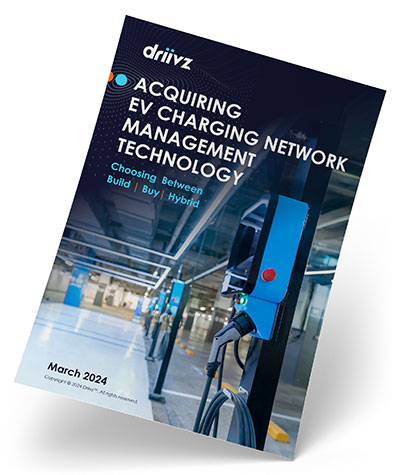The clock is ticking on carbon neutrality goals, which can only be reached with widespread electrification of transportation. Ramping up the pace of public EV charging infrastructure is essential to continuing the growth in electric vehicle (EV) adoption. But in order to scale and meet demand, players in the EV charging ecosystem will have to find ways to thrive in the face of significant challenges.
For EV charging industry participants, that means finding solutions that help them participate in the exponential growth of this complex market, meet EV driver expectations, forge new partnerships and business models, and scaling EV charging without disrupting the grid. Here’s a look at how these four challenges are impacting the industry today.
1. Exponential Growth in a Complex Market
The EV charging industry is experiencing exponential growth, spurred by government and utility incentives plus pledges of new spending from automotive manufacturers. Companies investing in building EV charging infrastructure need a back-end software platform that can scale readily to accommodate all facets of network growth: charger types, drivers, vehicles, transactions, roaming interfaces, and a wide range of charging use cases.
The participants in this ecosystem include a wide range of stakeholders with multiple business needs, including charge point operators (CPOs), government and private EV fleet operators, owners of commercial, industrial and multifamily properties, EV charging hosts partnering with EV charging network operators, and eMobility service providers (EMSPs).
Further complicating EV charging operations is the increasing variety of EV charging equipment made by different suppliers to address varying charging needs. These include Level 2 AC charging in office, commercial and multifamily residential parking; high-capacity, high-speed DC chargers for in-transit public charging; AC chargers designed for indoor and outdoor home and curbside charging. Although each charging need represents business opportunity, managing diversity requires a platform that is hardware agnostic and supports a wide range of business models.
2. Meeting EV Driver Expectations for a Seamless Charging Experience
Delivering a charging experience that is reliable and simple as fueling an internal combustion engine (ICE) vehicle remains a challenge. A physically damaged charger of course requires a site visit to fix. Chargers can also fault for software-related reasons. In that case, CPOs can provide a better driver experience with a back-end system that can communicate with chargers, detect and diagnose problems in real time, and enable remote actions to return the charger to a functioning state. Even better is a system with “self-healing” capabilities that handles these tasks through automation.

The other half of the driver experience is in paying for the charge. While it may seem fairly simple, there is enormous complexity behind the scenes and many ways to accept payments. Billing EV drivers and reconciliation with partners are two of the most complex aspects of running an EV charging business. The wide variety of use cases and business models together with the different players in the EV charging value chain make for an incredibly intricate matrix of variables that must all be covered by the EV charging management system.
3. New Partnerships and Business Models
As the EV charging market matures, more EV charging ecosystem companies looking to gain competitive advantage will meet their growth objectives through new partnerships, business models and mergers and acquisitions (M&As). Companies will have a variety of business goals, including entering new markets by acquiring existing EV charging networks. Others may be looking to gain vertical capabilities by acquiring ecosystem players for their technology or manufacturing capabilities.
The industry is also seeing more partnerships designed to expand public charging access and encourage EV adoption, such as the ongoing collaboration between EVgo and General Motors to increase the density of DC fast charging in metropolitan areas. Signaling the importance of public EV charging to EV adoption, seven large carmakers announced a joint venture to build a large EV charging network. And agreements between multiple automakers and Tesla changed the EV charging landscape with the companies all agreeing to support both the Tesla-originated NACS charging standard and the CCS charging standard.
4. Scaling EV Charging Without Straining the Grid
With the exponential growth of EVs and their power requirements for charging, it’s inevitable that grid operators and EV charging site operators will have to deal with energy limitations. One approach to addressing grid limitations is to flatten the demand curve, so that more consumption takes place at off-peak times – effectively lowering the peak load that utilities must meet. This can be accomplished in part by spot pricing or time-based pricing on the part of utilities to encourage off-peak consumption (and discourage peak consumption).
Where there are clusters of EV chargers in one locations, such as at fleet depots, office buildings, or multifamily properties, it will be necessary to optimize energy distribution among the chargers to cope with limitations of the existing grid. Another alternative is to integrate onsite renewables such as solar panels along with enterprise-grade battery storage, creating a microgrid to supplement the existing grid’s capacity.
Addressing Industry Challenges with Smart EV Charging and Energy Management
Companies navigating this rapidly evolving EV charging landscape can address the challenges discussed here with the right smart EV charging and smart energy management platform. The Driivz cloud-based, modular platform has a proven track record for enabling large global networks to deliver highly reliable EV charging services and a seamless driver experience while scaling rapidly to capture growth opportunities. Our advanced smart energy management system enables optimal utilization of the grid, leverages utility cost-saving options and demand response programs, and integrates EV charging with renewables, batteries, and building management systems.
To learn how Driivz can help your company thrive in today’s EV charging marketplace, reach out to one of our experts at [email protected].




